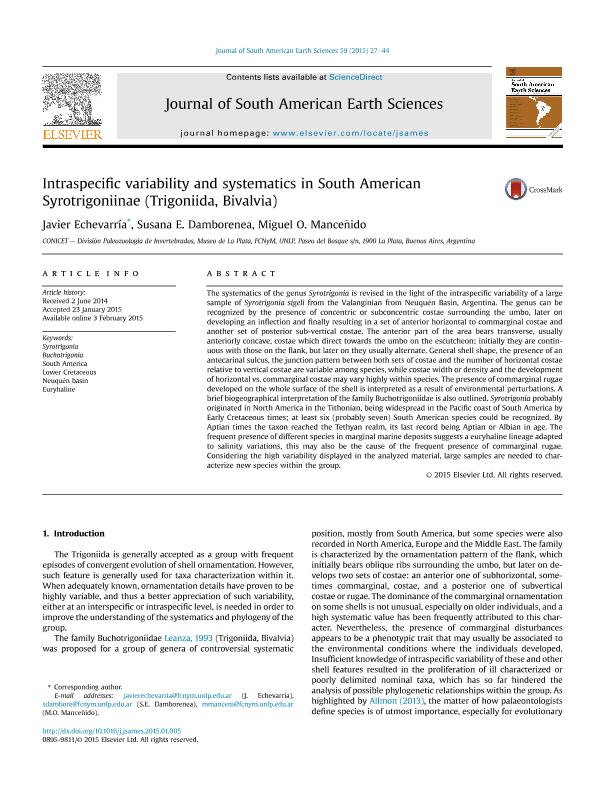Artículo
Intraspecific variability and systematics in South American Syrotrigoniinae (Trigoniida, Bivalvia)
Fecha de publicación:
04/2015
Editorial:
Pergamon-Elsevier Science Ltd
Revista:
Journal of South American Earth Sciences
ISSN:
0895-9811
Idioma:
Inglés
Tipo de recurso:
Artículo publicado
Clasificación temática:
Resumen
The systematics of the genus Syrotrigonia is revised in the light of the intraspecific variability of a large sample of Syrotrigonia sigeli from the Valanginian from Neuquén Basin, Argentina. The genus can be recognized by the presence of concentric or subconcentric costae surrounding the umbo, later on developing an inflection and finally resulting in a set of anterior horizontal to commarginal costae and another set of posterior sub-vertical costae. The anterior part of the area bears transverse, usually anteriorly concave, costae which direct towards the umbo on the escutcheon; initially they are continuous with those on the flank, but later on they usually alternate. General shell shape, the presence of an antecarinal sulcus, the junction pattern between both sets of costae and the number of horizontal costae relative to vertical costae are variable among species, while costae width or density and the development of horizontal vs. commarginal costae may vary highly within species. The presence of commarginal rugae developed on the whole surface of the shell is interpreted as a result of environmental perturbations. A brief biogeographical interpretation of the family Buchotrigoniidae is also outlined. Syrotrigonia probably originated in North America in the Tithonian, being widespread in the Pacific coast of South America by Early Cretaceous times; at least six (probably seven) South American species could be recognized. By Aptian times the taxon reached the Tethyan realm, its last record being Aptian or Albian in age. The frequent presence of different species in marginal marine deposits suggests a euryhaline lineage adapted to salinity variations, this may also be the cause of the frequent presence of commarginal rugae. Considering the high variability displayed in the analyzed material, large samples are needed to characterize new species within the group.
Archivos asociados
Licencia
Identificadores
Colecciones
Articulos(CCT - LA PLATA)
Articulos de CTRO.CIENTIFICO TECNOL.CONICET - LA PLATA
Articulos de CTRO.CIENTIFICO TECNOL.CONICET - LA PLATA
Citación
Echevarría, Javier; Damborenea, Susana Ester; Manceñido, Miguel Oscar; Intraspecific variability and systematics in South American Syrotrigoniinae (Trigoniida, Bivalvia); Pergamon-Elsevier Science Ltd; Journal of South American Earth Sciences; 59; 4-2015; 27-44
Compartir
Altmétricas




